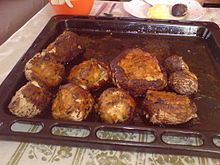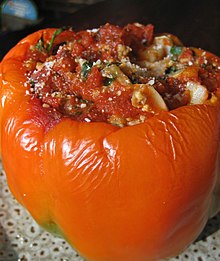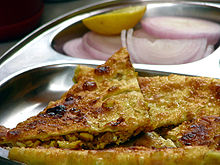Stuffing
This article needs additional citations for verification. (April 2008) |


In cooking, stuffing or filling (specifically for poultry) is an edible substance or mixture, often a starch, used to fill a cavity in another food item. Many foods may be stuffed, including meats, vegetables, egg, and fruits.
Turkey stuffing usually consists of bread crumbs or cubes, dried bread, with onion, celery, salt, pepper, and other spices and herbs such as summer savoury, sage, or a mixture like poultry seasoning. The term stuffing usually applies to the substance when it is placed into the bird, while dressing is usually used when cooked outside.
History

It is not known when stuffings were first used. The earliest documentary evidence is the Roman cookbook, Apicius'"De Re Coquinaria", which contains recipes for stuffed chicken, hare, pig, and dormouse. Most of the stuffings described consist of vegetables, herbs and spices, nuts, and spelt (an old cereal), and frequently contain chopped liver, brains, and other organ meat.[1][unreliable source?]
Names for stuffing include 'farce' (~1390), 'stuffing' (1538), 'forcemeat' (1688), and 'dressing'.[2] After about 1880, the term stuffing was replaced by dressing in Victorian English.[citation needed]
Cavities



In addition to stuffing the body cavity of animals, including mammals, birds, and fish, various cuts of meat may be stuffed after they have been deboned or a pouch has been cut into them. Popular recipes include stuffed chicken legs and stuffed breast of veal, as well as the traditional holiday stuffed goose or turkey.
Many types of vegetables are also suitable for stuffing after their seeds or flesh has been removed. Tomatoes, capsicums (sweet or hot peppers), also vegetable marrows (zucchini) may be prepared in this way. Cabbages and similar vegetables can also be stuffed or wrapped around a filling. They are usually blanched first, in order to make their leaves more pliable. Then, the interior may be replaced by stuffing, or small amounts of stuffing may be inserted between the individual leaves[citation needed].
It is sometimes claimed that the ancient Roman, as well as medieval, cooks stuffed animals with other animals. An anonymous Andalusian cookbook from the 13th century includes a recipe for a ram stuffed with small birds. A similar recipe for a camel stuffed with sheep stuffed with bustards stuffed with carp stuffed with eggs is mentioned in T.C. Boyle's book Water Music.
British celebrity chef Hugh Fearnley-Whittingstall has championed the ten-bird roast, calling it "one of the most spectacular and delicious roasts you can lay before your loved ones at Yuletide". A large turkey is stuffed with a goose, duck, mallard, guinea fowl, chicken, pheasant, partridge, pigeon and woodcock. The roast feeds around 30 people and as well as the ten birds, also includes stuffing made from two pounds of sausage meat and half a pound of streaky bacon along with sage, port and red wine.[3]
In the United States and Eastern Canada, multi-bird dishes are sometimes served on special occasions. See Turducken and Gooducken.
Fillers
Almost anything can serve as a stuffing, many popular Anglo-American stuffings contain bread or cereals, usually together with vegetables, herbs and spices, and eggs. Middle Eastern vegetable stuffings may be based on seasoned rice, on minced meat, or a combination. Other stuffings may contain only vegetables and herbs. Some types of stuffing contain sausage meat, or forcemeat, while vegetarian stuffings sometimes contain tofu. Oysters are used in one traditional stuffing for Thanksgiving. These may also be combined with mashed potatoes, for a heavy stuffing. Fruits and dried fruits are often added to stuffing including apples, dried prunes, apricots, and raisins. In England, a popular stuffing is sausage meat seasoned with various ingredients, sage, onion, apple, etc.
The stuffing mixture may be cooked separately and served as a side dish, in which case it may still be called 'stuffing', or in some regions, such as the Southern US, 'dressing'.
Food safety
The United States Department of Agriculture (USDA) states that cooking animals with a body cavity filled with stuffing can present potential food safety issues. These can occur because when the meat reaches a safe temperature, the stuffing inside can still harbor bacteria (and if the meat is cooked until the stuffing reaches a safe temperature, the meat may be overcooked). For turkeys, for instance, the USDA recommends cooking stuffing/dressing separately from the bird and not buying pre-stuffed birds (stuffing is never recommended for turkeys to be grilled, smoked, fried, or microwaved).[4]
See also
- Breadcrumb
- Breading
- Forcemeat
- Stove Top stuffing
- Panade, a dish that is a precursor to stuffing.
- Paxo
- Sarma and Dolma, stuffed vegetables in the tradition of Ottoman cuisine
- Stuffed pepper
- Mrs. Cubbison's Foods
References
- ^ Stuffing - Food Facts & History
- ^ Oxford English Dictionary
- ^ Daily Mail, 10 December 2005 http://www.dailymail.co.uk/pages/live/articles/christmas/christmas.html?in_article_id=372276&in_page_id=1322&ct=5 [dead link]
- ^ Turkey Basics: Stuffing

